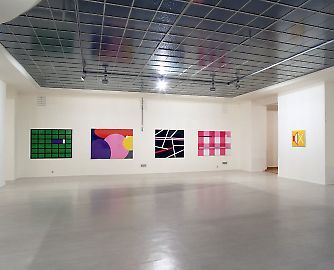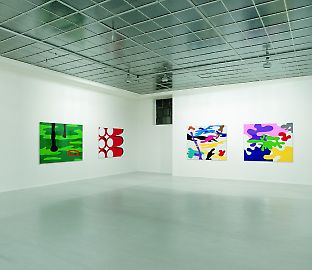Gerwald Rockenschaub --
The outcome of Roland Barthes’ examination of “everyday myths” in the 1950s was surprising. In the interpretation of the symbols, everything that plays with the lack of clarity of the actual meaning could be mythical according to Barthes, because “a myth can neither be an object nor a term nor an idea; it is a method of interpretation, a form.” (1) In this respect, according to Barthes, it is the societal discourse which causes a statement to become a myth: […] This thought is indebted to the triumph of the pop culture, in which the differences between high and low are nullified by the visual codes. Not much about this basic understanding has changed up to the present: the Love Parade as an event still comes to life through the images it produces and their massive circulation that ingrains them in the public mind. […]
One of the most important things left over from the club culture within the art context in Rockenschaub’s work are reduced symbols. […]
Using a drawing program on the computer, he develops abstract motifs which are read as data, cut out from color foils and mounted on Alucore. The image that appears is no longer based on color as the original material, but it has already been industrially prefabricated. The use of this method causes the traces of hand-made work to disappear even more completely than in his earlier silk-screen prints: the image created is an expression of a visual culture which is no longer capable of designing without the use of electronic communication technology and its appropriate devices. The media painting is code enough.
This is also the origin of the following motifs: the logos between semi-conductor and play station, the abstract modulus in science and entertainment. Even the language of the club scene’s images is reduced to the technical furnishings, such as: the record player, sound mixer and speakers. “The game functions within technical boundaries. One has to be willing to deal with the devices. It is no longer only about the use of color, one has to make decisions more quickly all together,” says Rockenschaub on his relationship to the computer and in dealing with the production of images.(2) Rockenschaub hardly works in a different manner on his artwork than he does on his electronic tracks, produced under the label definitely something: ”Whenever I think of something, I write it down in my sequences program, and if I don’t like it, I correct it or erase it again. It [my work] always has something to do with production conditions that lead to certain consequences and create a certain state of mind.“(3)
(1) Roland Barthes, Die Mythen des Alltags, suhrkamp: Frankfurt/Main 1964, p. 85
(2) Gerwald Rockenschaub in an interview with Jan Winkelmann, Hamburg, Feb.13, 1997
(3) Ibid
Harald Fricke, “Painting without Myth, Between Semiconductor and Play Station: On Gerwald Rockenschaub’s Latest Work,” in: catalogue Gerwald Rockenschaub 1999, Georg Kargl Fine Arts, Vienna 1999, no page.






